The Effect of Different Plant Oil Impregnation and Hardening Temperatures on Physical-Mechanical Properties of Modified Biocomposite Boards Made of Hemp Shives and Corn Starch
Abstract
1. Introduction
2. Materials and Methods
2.1. Preparation of BcBs and Their Impregnation with Oils of the Plant Origin
2.2. Oil Thin Film Micro-Oxidation Test
2.3. Measurements of Physical and Mechanical Properties
3. Results and Discussion
3.1. Oxidation of Different Types of Oils and Formation of Oil Films
3.2. Oil Penetration into the Biocomposites Boards
3.3. Water and Moisture Resistance Properties of Oil-Impregnated BcBs
3.4. Mechanical Performance of Oil-Impregnated BcBs
3.5. Density and Thermal Conductivity of Oil-Impregnated BcBs
4. Conclusions
Author Contributions
Funding
Conflicts of Interest
References
- Vasiliauskienė, D.; Balčiūnas, G.; Urbonavičius, J. Isolation and identification of fungi growing on fibre hemp shive based thermal insulation materials. In Proceedings of the 21th Conference for Junior Researchers “Science–Future of Lithuania“, Environmental protection engineering, Vilnius, Lithuania, 20 March 2018; pp. 47–51. [Google Scholar] [CrossRef]
- Jiang, Y.; Lawrence, M.; Ansell, M.P.; Hussain, A. Cell wall microstructure, pore size distribution and absolute density of hemp shiv. R. Soc. Open Sci. 2018, 5. [Google Scholar] [CrossRef] [PubMed]
- Hussain, A.; Calabria-Holley, J.; Schorr, D.; Jiang, Y.; Lawrence, M.; Blanchet, P. Applied Surface Science Hydrophobicity of hemp shiv treated with sol-gel coatings. Appl. Surf. Sci. 2018, 434, 850–860. [Google Scholar] [CrossRef]
- Teacă, C.A.; Roşu, D.; Mustaţă, F.; Rusu, T.; Roşu, L.; Roşca, I.; Varganici, C.D. Natural bio-based products for wood coating and protection against degradation: A review. BioResources 2019, 14, 4873–4901. [Google Scholar] [CrossRef]
- Xu, X.; Chen, L.; Guo, J.; Cao, X.; Wang, S. Synthesis and characteristics of tung oil-based acrylated-alkyd resin modified by isobornyl acrylate. RSC Adv. 2017, 7, 30439–30445. [Google Scholar] [CrossRef]
- Veigel, S.; Lems, E.; Grüll, G.; Hansmann, C. Simple Green Route to Performance Improvement of Fully Bio-Based Linseed Oil Coating Using nanofibrillated cellulose. Polymers 2017, 9, 425. [Google Scholar] [CrossRef]
- Siano, F.; Moccia, S.; Picariello, G.; Russo, G.L.; Sorrentino, G.; Di Stasio, M.; La Cara, F.; Volpe, M.G. Comparative study of chemical, biochemical characteristic and ATR-FTIR analysis of seeds, oil and flour of the edible Fedora cultivar hemp (Cannabis sativa L.). Molecules 2019, 24, 83. [Google Scholar] [CrossRef]
- Callaway, J.C. Hempseed as a nutritional resource: An overview. Euphytica 2004, 140, 65–72. [Google Scholar] [CrossRef]
- Anusic, A.; Resch-Fauster, K.; Mahendran, A.R.; Wuzella, G. Anhydride Cured Bio-Based Epoxy Resin: Effect of Moisture on Thermal and Mechanical Properties. Macromol. Mater. Eng. 2019, 304, 1900031. [Google Scholar] [CrossRef]
- Lazzari, M.; Chiantore, O. Drying and oxidative degradation of linseed oil. Polym. Degrad. Stab. 1999, 65, 303–313. [Google Scholar] [CrossRef]
- Oyman, Z.O.; Ming, W.; Van Der Linde, R. Oxidation of drying oils containing non-conjugated and conjugated double bonds catalyzed by a cobalt catalyst. Prog. Org. Coat. 2005, 54, 198–204. [Google Scholar] [CrossRef]
- Dotan, A. Biobased Thermosets; Elsevier Inc.: Amsterdam, The Netherlands, 2014; ISBN 9781455731077. [Google Scholar]
- Bayrak, A.; Kiralan, M.; Ipek, A.; Arslan, N.; Cosge, B.; Khawar, K.M. Fatty acid compositions of linseed (Linum Usitatissimum L.) genotypes of different origin cultivated in Turkey. Biotechnol. Biotechnol. Equip. 2010, 24, 1836–1842. [Google Scholar] [CrossRef]
- Teh, S.S.; Birch, J. Physicochemical and quality characteristics of cold-pressed hemp, flax and canola seed oils. J. Food Compos. Anal. 2013, 30, 26–31. [Google Scholar] [CrossRef]
- Janesch, J.; Arminger, B.; Gindl-Altmutter, W.; Hansmann, C. Superhydrophobic coatings on wood made of plant oil and natural wax. Prog. Org. Coat. 2020, 148, 105891. [Google Scholar] [CrossRef]
- Chang, C.W.; Lee, H.L.; Lu, K.T. Manufacture and characteristics of oil-modified refined lacquer for wood coatings. Coatings 2019, 9, 11. [Google Scholar] [CrossRef]
- EN 12667. Thermal Performance of Building Materials and Products—Determination of Thermal Resistance by Means of Guarded Hot Plate and Heat Flow Meter Methods; European Standardization Committee: Brussels, Belgium, 2002. [Google Scholar]
- EN ISO 4590. Rigid Cellular Plastics—Determination of the Volume Percentage of Open Cells and of Closed Cells; European Standardization Committee: Brussels, Belgium, 2016. [Google Scholar]
- EN 826. Thermal Insulating Products for Building Applications—Determination of Compression Behavior; European Standardization Committee: Brussels, Belgium, 2013. [Google Scholar]
- EN ISO 29767. Thermal Insulating Products for Building Applications—Determination of Short-Term Water Absorption by Partial Immersion; European Standardization Committee: Brussels, Belgium, 2019. [Google Scholar]
- EN 317. Particleboards and Fibreboards—Determinations of Swelling in Thickness after Immersion in Water; European Standardization Committee: Brussels, Belgium, 1999. [Google Scholar]
- EN 1604. Thermal Insulating Products for Building Applications—Determination of Dimensional Stability under Specified Temperature and Humidity Conditions; European Standardization Committee: Brussels, Belgium, 2013. [Google Scholar]
- Liang, J.; Appukuttan Aachary, A.; Hollader, U.T. Hemp seed oil: Minor components and oil quality. Lipid Technol. 2015, 27, 231–233. [Google Scholar] [CrossRef]
- Dlugogorski, B.Z.; Kennedy, E.M.; Mackie, J.C. Low temperature oxidation of linseed oil: A review. Fire Sci. Rev. 2012, 1, 3. [Google Scholar] [CrossRef]
- Przybylak, M.; Maciejewski, H.; Dutkiewicz, A.; Wesołek, D.; Władyka-Przybylak, M. Multifunctional, strongly hydrophobic and flame-retarded cotton fabrics modified with flame retardant agents and silicon compounds. Polym. Degrad. Stab. 2016, 128, 55–64. [Google Scholar] [CrossRef]
- Yao, T.; Zhang, Y.; Xiao, Y.; Zhao, P.; Guo, L.; Yang, H.; Li, F. The effect of environmental factors on the adsorption of lubricating oil onto expanded graphite. J. Mol. Liq. 2016, 218, 611–614. [Google Scholar] [CrossRef]
- Beg, M.D.H.; Pickering, K.L. Reprocessing of wood fibre reinforced polypropylene composites. Part II: Hygrothermal ageing and its effects. Compos. Part A Appl. Sci. Manuf. 2008, 39, 1565–1571. [Google Scholar] [CrossRef]
- Chalapud, M.C.; Herdt, M.; Nicolao, E.S.; Ruseckaite, R.A.; Ciannamea, E.M.; Stefani, P.M. Biobased particleboards based on rice husk and soy proteins: Effect of the impregnation with tung oil on the physical and mechanical behavior. Constr. Build. Mater. 2020, 230, 116996. [Google Scholar] [CrossRef]
- He, Z.; Qian, J.; Qu, L.; Yan, N.; Yi, S. Effects of Tung oil treatment on wood hygroscopicity, dimensional stability and thermostability. Ind. Crops Prod. 2019, 140, 111647. [Google Scholar] [CrossRef]
- Gao, W.; Wu, W.; Liu, P.; Hou, H.; Li, X.; Cui, B. Preparation and evaluation of hydrophobic biodegradable films made from corn/octenylsuccinated starch incorporated with different concentrations of soybean oil. Int. J. Biol. Macromol. 2020, 142, 376–383. [Google Scholar] [CrossRef] [PubMed]
- Hassan, M.M.; Tucker, N.; Le Guen, M.J. Thermal, mechanical and viscoelastic properties of citric acid-crosslinked starch/cellulose composite foams. Carbohydr. Polym. 2020, 230, 115675. [Google Scholar] [CrossRef] [PubMed]
- Farajpour, R.; Emam Djomeh, Z.; Moeini, S.; Tavahkolipour, H.; Safayan, S. Structural and physico-mechanical properties of potato starch-olive oil edible films reinforced with zein nanoparticles. Int. J. Biol. Macromol. 2020, 149, 941–950. [Google Scholar] [CrossRef] [PubMed]
- Abd Karim, N.; Lamaming, J.; Yusof, M.; Hashim, R.; Sulaiman, O.; Hiziroglu, S.; Wan Nadhari, W.N.A.; Salleh, K.M.; Taiwo, O.F. Properties of native and blended oil palm starch with nano-silicon dioxide as binder for particleboard. J. Build. Eng. 2020, 29, 101151. [Google Scholar] [CrossRef]
- Lee, S.H.; Ashaari, Z.; Lum, W.C.; Abdul Halip, J.; Ang, A.F.; Tan, L.P.; Chin, K.L.; Md Tahir, P. Thermal treatment of wood using vegetable oils: A review. Constr. Build. Mater. 2018, 181, 408–419. [Google Scholar] [CrossRef]
- Bak, M.; Németh, R. Changes in swelling properties and moisture uptake rate of oil-heat-treated poplar (Populus × euramericana cv. pannónia) wood. BioResources 2012, 7, 5128–5137. [Google Scholar] [CrossRef][Green Version]
- Cheng, D.; Chen, L.; Jiang, S.; Zhang, Q. Oil uptake percentage in oil-heat-treated wood, its determination by Soxhlet extraction, and its effects on wood compression strength parallel to the grain. BioResources 2014, 9, 120–131. [Google Scholar] [CrossRef]
- Mosiewicki, M.; Borrajo, J.; Aranguren, M.I. Mechanical properties of woodflour/linseed oil resin composites. Polym. Int. 2005, 54, 829–836. [Google Scholar] [CrossRef]
- Zhang, Z.; Li, D.; Xu, M.; Li, B. Synthesis of a novel phosphorus and nitrogen-containing flame retardant and its application in rigid polyurethane foam with expandable graphite. Polym. Degrad. Stab. 2020, 173, 109077. [Google Scholar] [CrossRef]
- da Silva, R.S.R.; Oishi, S.S.; Botelho, E.C.; Ferreira, N.G. Carbon foam composites based on expanded graphite for electrochemical application. Diam. Relat. Mater. 2020, 103, 107730. [Google Scholar] [CrossRef]
- Jeon, J.; Park, J.H.; Wi, S.; Yang, S.; Ok, Y.S.; Kim, S. Characterization of biocomposite using coconut oil impregnated biochar as latent heat storage insulation. Chemosphere 2019, 236, 124269. [Google Scholar] [CrossRef] [PubMed]
- Hussain, A.; Calabria-Holley, J.; Lawrence, M.; Jiang, Y. Hygrothermal and mechanical characterisation of novel hemp shiv based thermal insulation composites. Constr. Build. Mater. 2019, 212, 561–568. [Google Scholar] [CrossRef]
- Ho, Q.B.; Osazuwa, O.; Modler, R.; Daymond, M.; Gallerneault, M.T.; Kontopoulou, M. Exfoliation of graphite and expanded graphite by melt compounding to prepare reinforced, thermally and electrically conducting polyamide composites. Compos. Sci. Technol. 2019, 176, 111–120. [Google Scholar] [CrossRef]
- Guo, X.; Zhang, S.; Cao, J. An energy-efficient composite by using expanded graphite stabilized paraffin as phase change material. Compos. Part A Appl. Sci. Manuf. 2018, 107, 83–93. [Google Scholar] [CrossRef]
- Li, A.; Zhang, C.; Zhang, Y.F. Thermal conductivity of graphene-polymer composites: Mechanisms, properties, and applications. Polymers 2017, 9, 437. [Google Scholar] [CrossRef]
- Teng, C.C.; Ma, C.C.M.; Lu, C.H.; Yang, S.Y.; Lee, S.H.; Hsiao, M.C.; Yen, M.Y.; Chiou, K.C.; Lee, T.M. Thermal conductivity and structure of non-covalent functionalized graphene/epoxy composites. Carbon N. Y. 2011, 49, 5107–5116. [Google Scholar] [CrossRef]
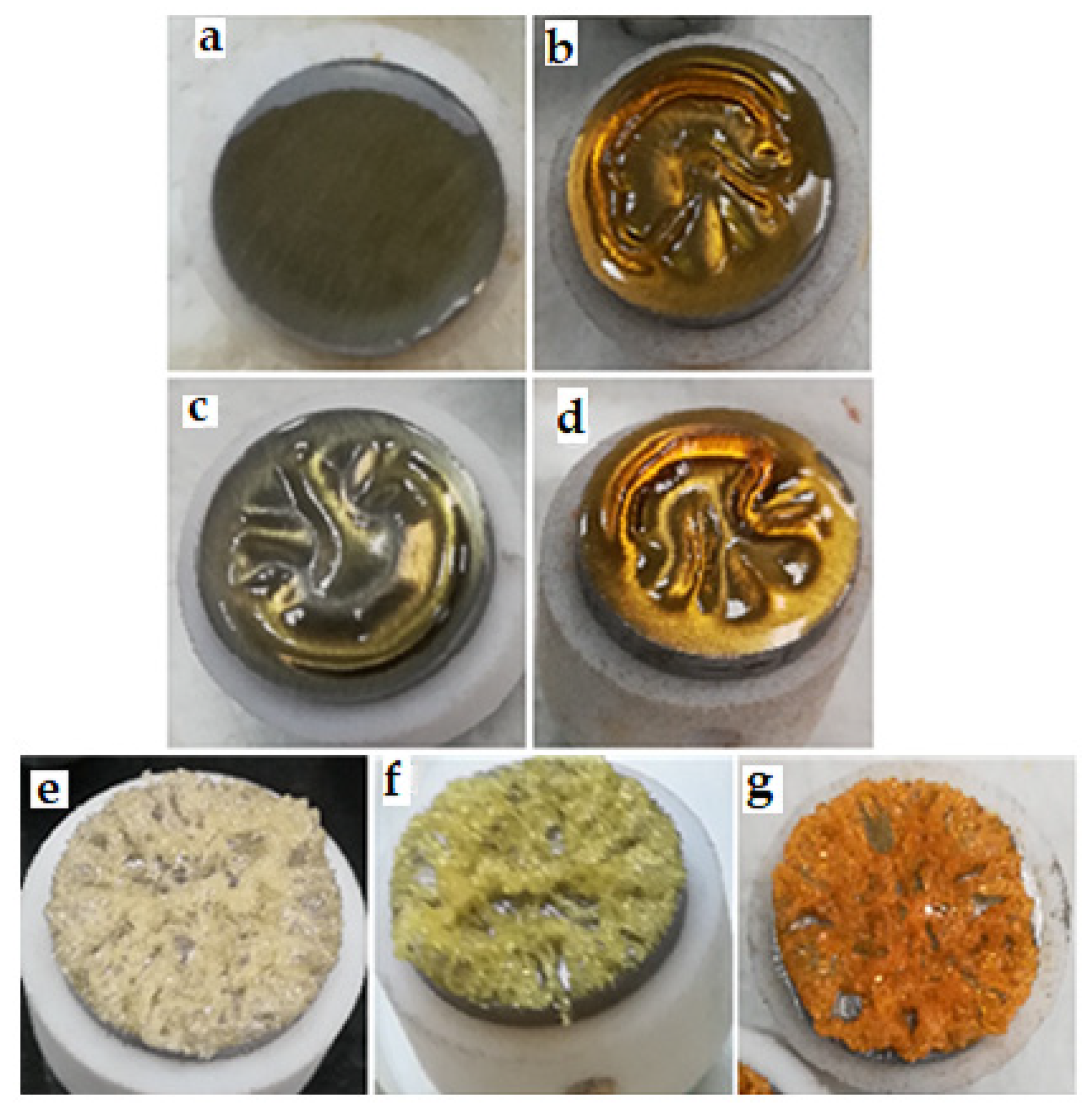
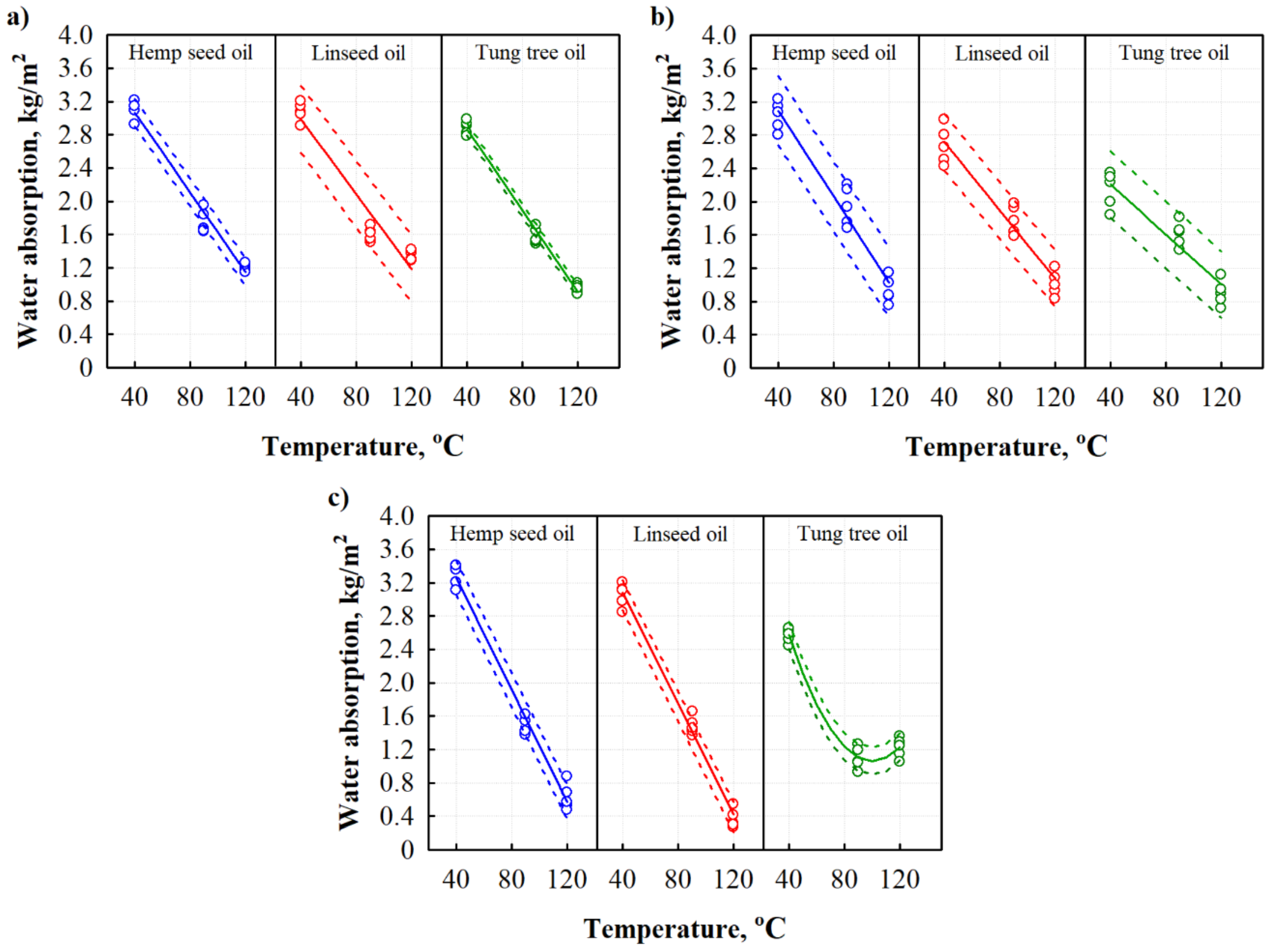
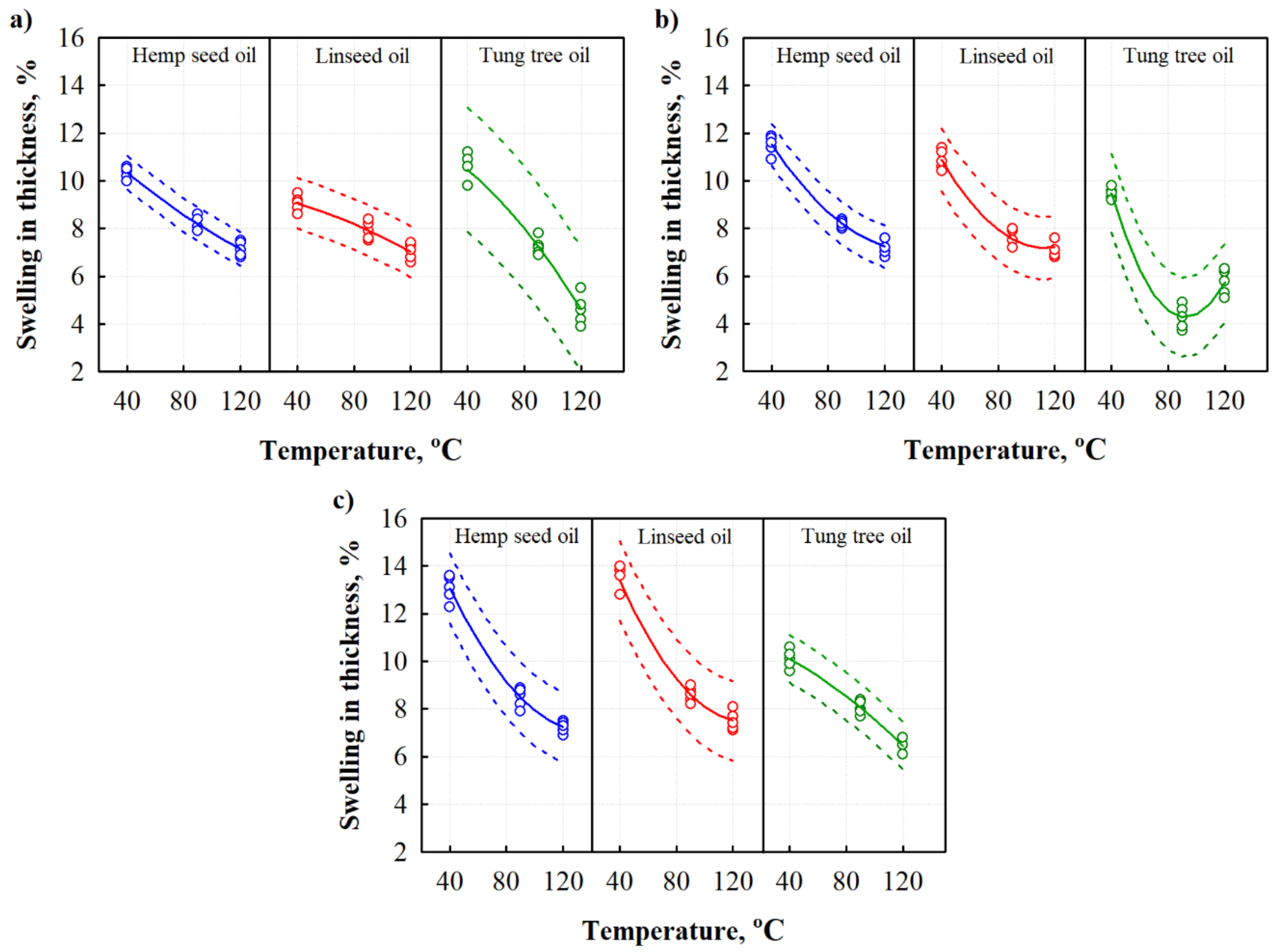
 40 °C,
40 °C,  90 °C,
90 °C,  120 °C. F, G and H—BcB composition, K—hempseed oil, L—linseed oil, T—tung tree oil, and Δεd—the change in thickness.
120 °C. F, G and H—BcB composition, K—hempseed oil, L—linseed oil, T—tung tree oil, and Δεd—the change in thickness.
 40 °C,
40 °C,  90 °C,
90 °C,  120 °C. F, G and H—BcB composition, K—hempseed oil, L—linseed oil, T—tung tree oil, and Δεd—the change in thickness.
120 °C. F, G and H—BcB composition, K—hempseed oil, L—linseed oil, T—tung tree oil, and Δεd—the change in thickness.
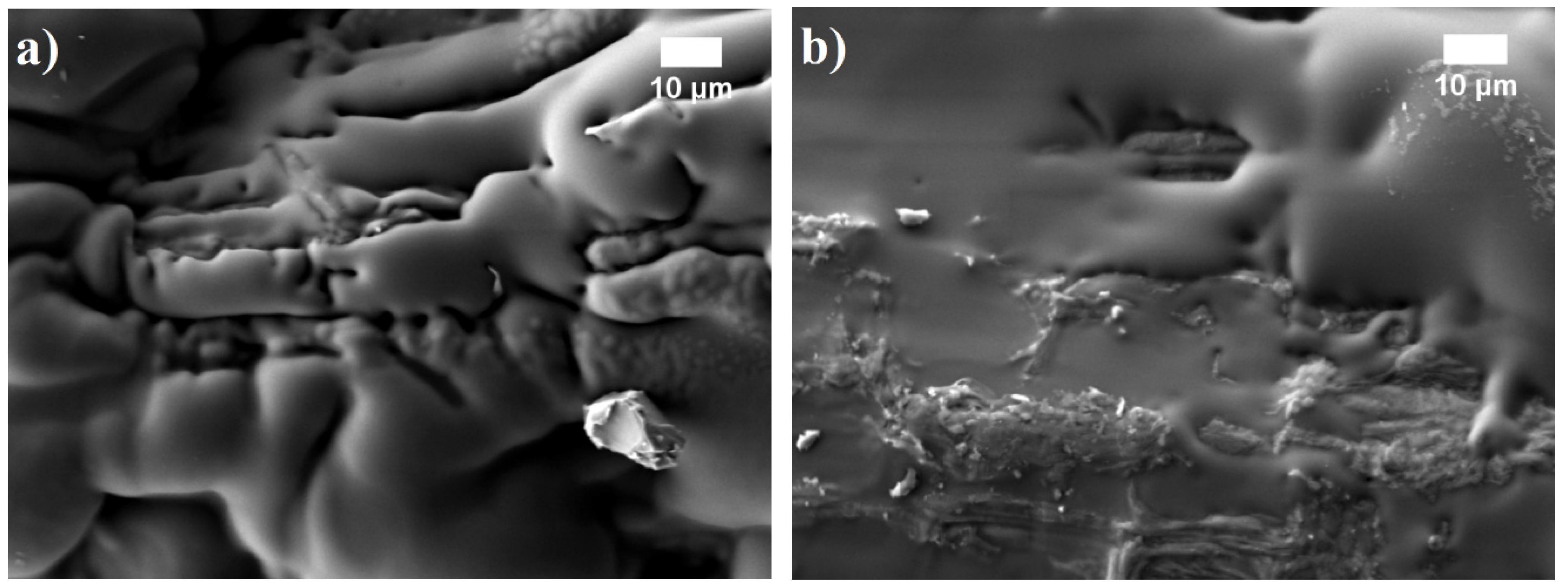
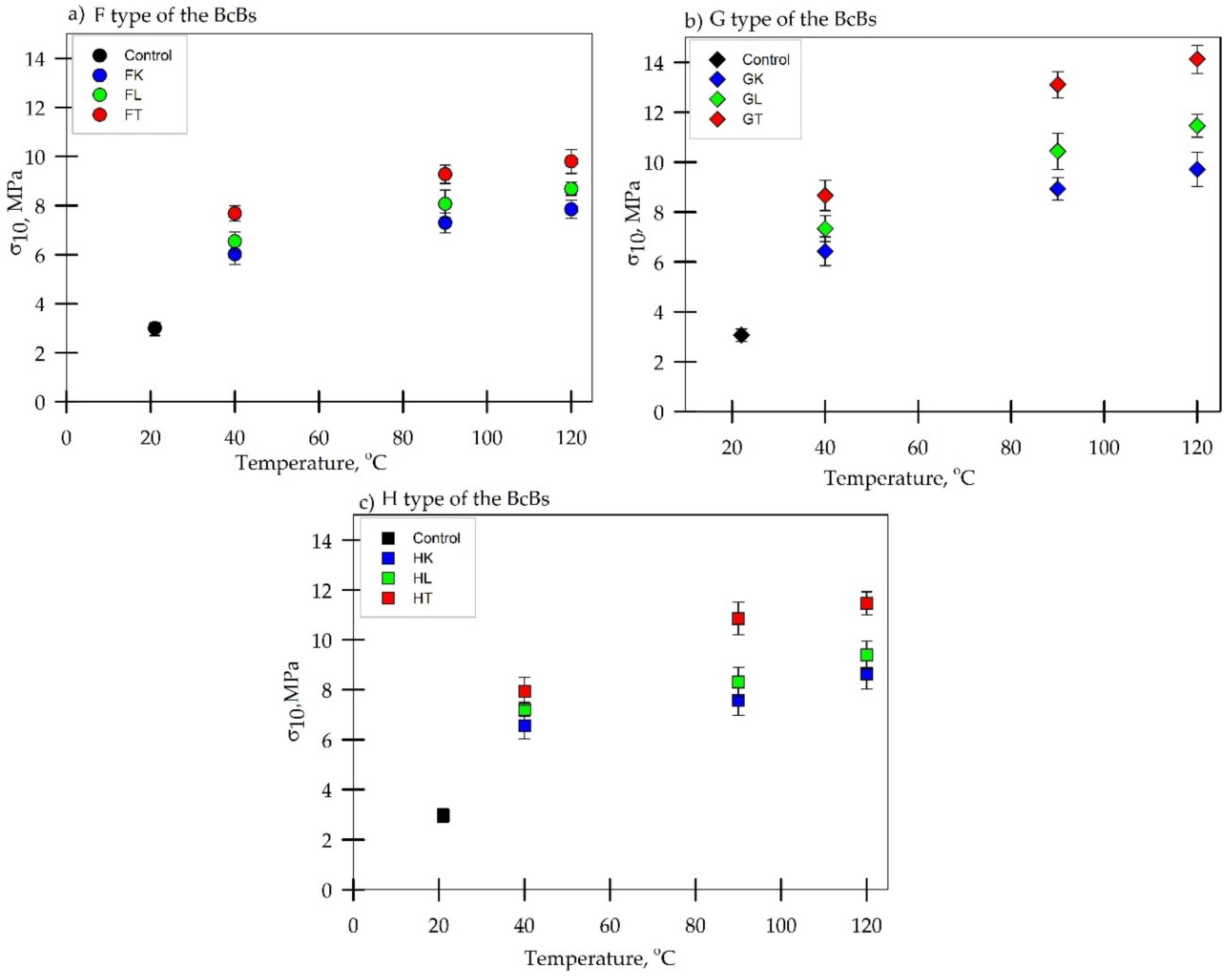
 —linseed oil,
—linseed oil,  —tung tree oil,
—tung tree oil,  —without oil treatment: solid-type bars—specimens which were dried at 70 °C to constant weight; pattern-type bars—specimens which were dried at 23 ± 2 °C and 50 ± 2% conditions to constant weight.
—without oil treatment: solid-type bars—specimens which were dried at 70 °C to constant weight; pattern-type bars—specimens which were dried at 23 ± 2 °C and 50 ± 2% conditions to constant weight.
 —linseed oil,
—linseed oil,  —tung tree oil,
—tung tree oil,  —without oil treatment: solid-type bars—specimens which were dried at 70 °C to constant weight; pattern-type bars—specimens which were dried at 23 ± 2 °C and 50 ± 2% conditions to constant weight.
—without oil treatment: solid-type bars—specimens which were dried at 70 °C to constant weight; pattern-type bars—specimens which were dried at 23 ± 2 °C and 50 ± 2% conditions to constant weight.
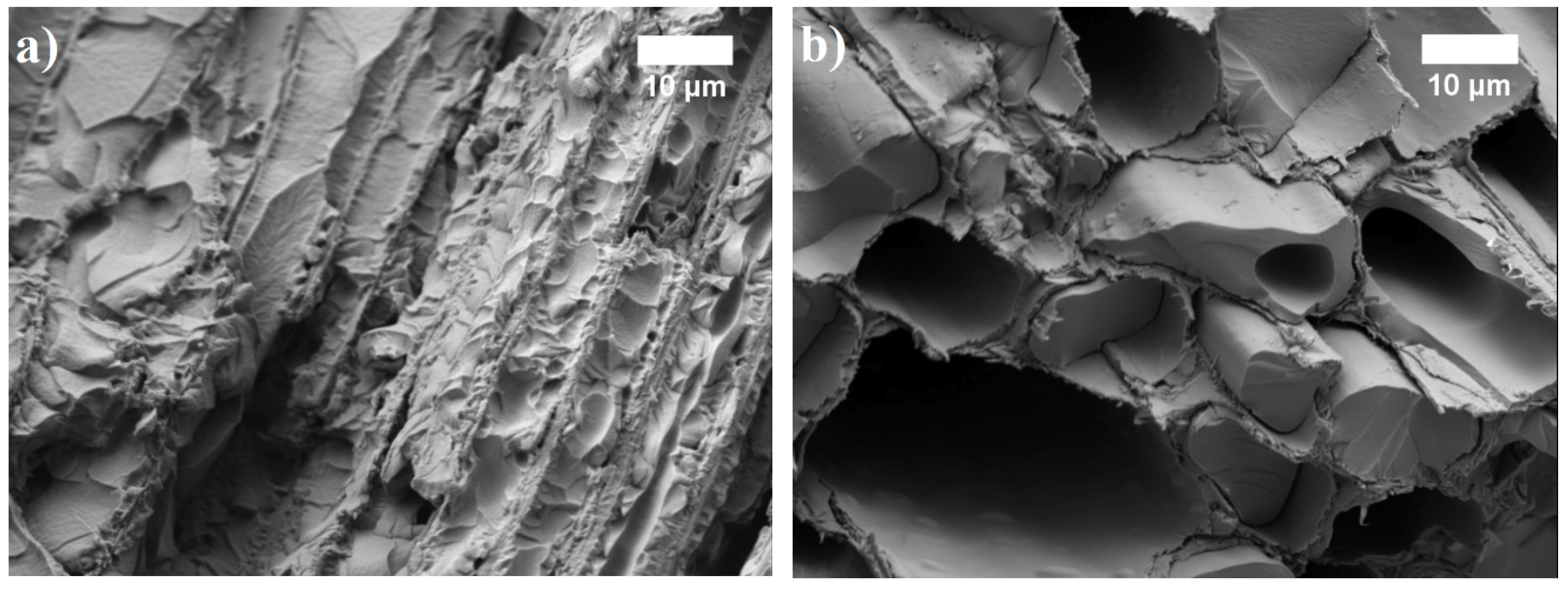
 —linseed oil,
—linseed oil,  —tung tree oil,
—tung tree oil,  —without oil treatment: solid-type bars—specimens which were dried at 70 °C to constant weight; pattern-type bars—specimens which were conditioned at (23 ± 2) °C and (50 ± 2)% to constant weight.
—without oil treatment: solid-type bars—specimens which were dried at 70 °C to constant weight; pattern-type bars—specimens which were conditioned at (23 ± 2) °C and (50 ± 2)% to constant weight.
 —linseed oil,
—linseed oil,  —tung tree oil,
—tung tree oil,  —without oil treatment: solid-type bars—specimens which were dried at 70 °C to constant weight; pattern-type bars—specimens which were conditioned at (23 ± 2) °C and (50 ± 2)% to constant weight.
—without oil treatment: solid-type bars—specimens which were dried at 70 °C to constant weight; pattern-type bars—specimens which were conditioned at (23 ± 2) °C and (50 ± 2)% to constant weight.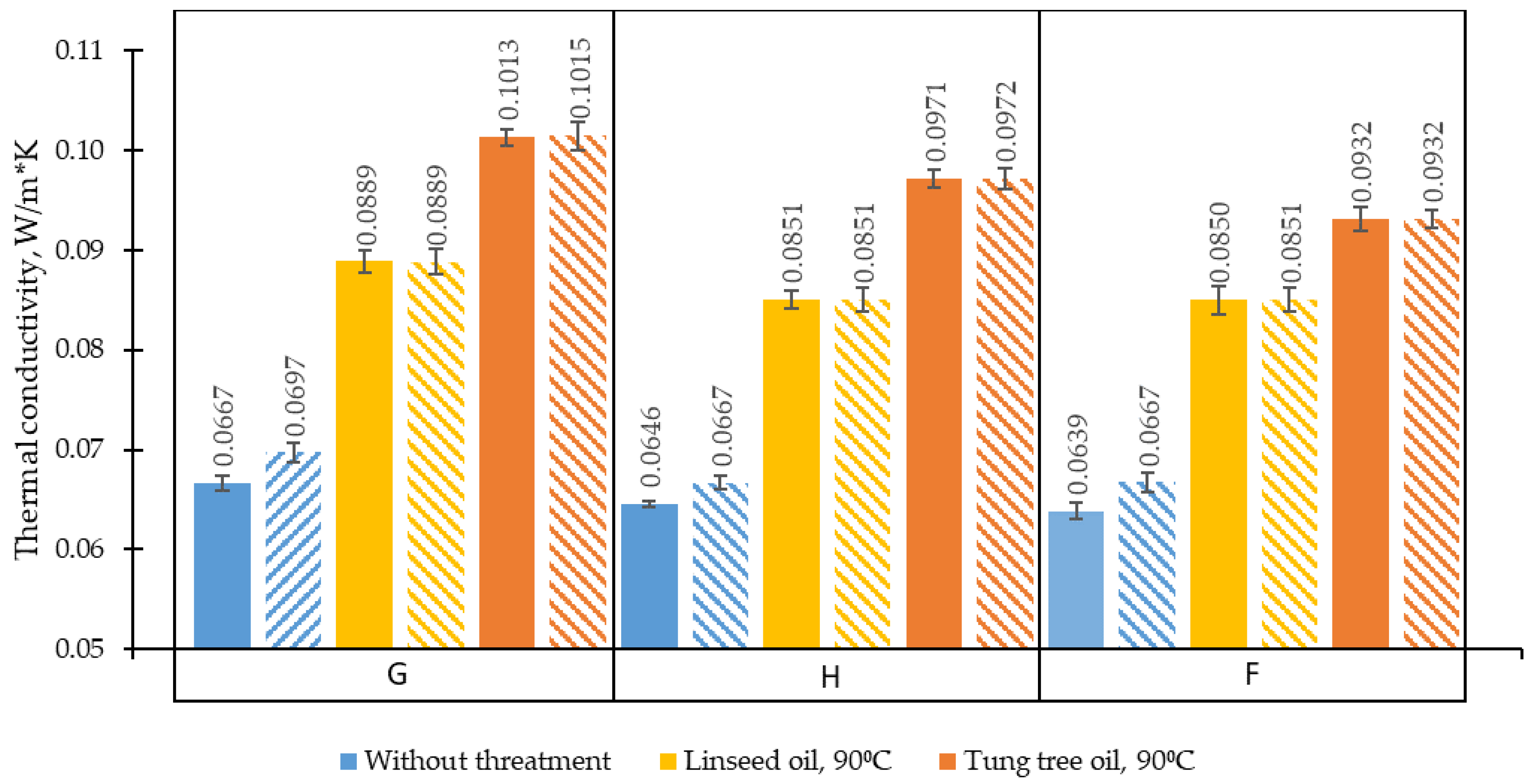
| Fatty Acid Composition (%) | Tung Tree Oil [5,11] | Linseed [12,13,14] | Hempseed Oil [8,14] |
|---|---|---|---|
| Palmitic acid (C16:0) | 3–5.2 | 6–7 | 4–8 |
| Oleic acid (C18:1) | 4–11 | 14–24 | 8–17 |
| Stearic acid (18:0) | 2 | 3–6 | 2–3 |
| Linoleic acid (C18:2) | 7.5–15 | 14–19 | 50–70 |
| α-linolenic acid (C18:3(n-3)) | 3 | 48–60 | 12–25 |
| γ-linolenic acid (C18:3(n-6)) | nd | nd | 0–6.8 |
| α-eleostearic acid (C18:3(9Z,11E,13E)) | 59–83.3 | nd | nd |
| Oil | Total Changes % of the Mass |
|---|---|
| Hempseed | 1.77 ± 0.52 |
| Linseed | 2.87 ± 0.18 |
| Tung tree | 3.49 ± 0.34 |
| Type of the BcB | Characteristic | Hempseed Oil | Linseed Oil | Tung Tree Oil |
|---|---|---|---|---|
| F | Oil penetration into the BcB, % | 55.1 ± 12.6 | 63.4 ± 24.5 | 43.3 ± 5.81 |
| G | Oil penetration into the BcB, % | 81.8 ± 14.2 | 93.4 ± 20.6 | 85.5 ± 19.7 |
| H | Oil penetration into the BcB, % | 61.6 ± 16.9 | 68.2 ± 14.6 | 70.2 ± 18.2 |
| Type of Composition (1) | Equation Coefficients | , kg/m2 | |||
|---|---|---|---|---|---|
| FK * | 4.028878 | −0.024027 | – | 0.976 | 0.0645 |
| FL * | 3.887878 | −0.022527 | – | 0.936 | 0.156 |
| FT * | 3.841122 | −0.024373 | – | 0.989 | 0.0298 |
| GK * | 4.127531 | −0.025818 | – | 0.949 | 0.163 |
| GL * | 3.535184 | −0.020510 | – | 0.935 | 0.132 |
| GT * | 2.805347 | −0.015008 | – | 0.867 | 0.156 |
| HK * | 4.603347 | −0.033608 | – | 0.985 | 0.0799 |
| HL * | 4.411469 | −0.033282 | – | 0.988 | 0.0601 |
| HT ** | 5.251000 | −0.083675 | 0.000418 | 0.977 | 0.0432 |
| Type of Composition (1) | Equation Coefficients | , % | |||
|---|---|---|---|---|---|
| FK | 12.45200 | −0.057067 | 0.000107 | 0.964 | 0.275 |
| FL | 9.678000 | −0.012183 | −0.000082 | 0.873 | 0.414 |
| FT | 11.97400 | −0.026050 | −0.000295 | 0.960 | 1.01 |
| GK | 15.72400 | −0.122300 | 0.000430 | 0.976 | 0.344 |
| GL | 15.98400 | −0.154800 | 0.000680 | 0.957 | 0.510 |
| GT | 20.51000 | −0.352083 | 0.001908 | 0.969 | 0.646 |
| HK | 18.98600 | −0.173283 | 0.000628 | 0.978 | 0.575 |
| HL | 19.91000 | −0.192417 | 0.000742 | 0.977 | 0.649 |
| HT | 11.16800 | −0.020433 | −0.000157 | 0.960 | 0.389 |
| Parameter | Type of BcB | ||
|---|---|---|---|
| Open Porosity, vol.% | G | H | F |
| Control BcB | |||
| 18.3 ± 0.77 | 20.2 ± 0.59 | 18.1 ± 0.57 | |
| BcB with linseed oil | |||
| 12.2 ± 0.64 | 13.7 ± 0.80 | 12.5 ± 0.62 | |
| BcB with tung tree oil | |||
| 10.1 ± 0.64 | 11.3 ± 0.69 | 11.0 ± 0.46 | |
Publisher’s Note: MDPI stays neutral with regard to jurisdictional claims in published maps and institutional affiliations. |
© 2020 by the authors. Licensee MDPI, Basel, Switzerland. This article is an open access article distributed under the terms and conditions of the Creative Commons Attribution (CC BY) license (http://creativecommons.org/licenses/by/4.0/).
Share and Cite
Vasiliauskienė, D.; Balčiūnas, G.; Boris, R.; Kairytė, A.; Kremensas, A.; Urbonavičius, J. The Effect of Different Plant Oil Impregnation and Hardening Temperatures on Physical-Mechanical Properties of Modified Biocomposite Boards Made of Hemp Shives and Corn Starch. Materials 2020, 13, 5275. https://doi.org/10.3390/ma13225275
Vasiliauskienė D, Balčiūnas G, Boris R, Kairytė A, Kremensas A, Urbonavičius J. The Effect of Different Plant Oil Impregnation and Hardening Temperatures on Physical-Mechanical Properties of Modified Biocomposite Boards Made of Hemp Shives and Corn Starch. Materials. 2020; 13(22):5275. https://doi.org/10.3390/ma13225275
Chicago/Turabian StyleVasiliauskienė, Dovilė, Giedrius Balčiūnas, Renata Boris, Agnė Kairytė, Arūnas Kremensas, and Jaunius Urbonavičius. 2020. "The Effect of Different Plant Oil Impregnation and Hardening Temperatures on Physical-Mechanical Properties of Modified Biocomposite Boards Made of Hemp Shives and Corn Starch" Materials 13, no. 22: 5275. https://doi.org/10.3390/ma13225275
APA StyleVasiliauskienė, D., Balčiūnas, G., Boris, R., Kairytė, A., Kremensas, A., & Urbonavičius, J. (2020). The Effect of Different Plant Oil Impregnation and Hardening Temperatures on Physical-Mechanical Properties of Modified Biocomposite Boards Made of Hemp Shives and Corn Starch. Materials, 13(22), 5275. https://doi.org/10.3390/ma13225275







